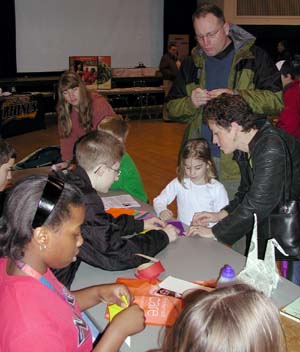
Japanese legend has it that anyone who folds 1,000 paper cranes will be granted a wish. The legend was told to a Japanese girl named Sadako Sasaki, born in 1943, when she was 11 years old and fell ill with leukemia. It was said that Sadako began folding the paper cranes in the hopes that the gods would grant her wish of regaining her health. She managed to fold 1,000 cranes before her death and her determination to complete the project has become a symbol of hope and perseverance. Her friends and classmates continued her work after her death, compiled a book about her life and began raising money to build a monument to Sadako. The statue, unveiled in Hiroshima Peace Park in Japan, was completed in 1958 and features a little girl holding a golden crane. Today, people across the world continue folding paper cranes, stringing them onto chains and sending them to the monument. Now, closer to home, Cool Kids organizer Steve Appleton has been working with various groups and schools to undertake the intricate origami folding art in an effort to complete 1,000. The weekend of January 14-15, some seventh graders from John Marshall High School in Rochester helped Cold Rush attendees at the Rochester Museum and Science Center learn how to make the cranes. Some of those created at that event will go toward achieving the grand total. Largely, however, participants learning the art were anxious to take their cranes home with them. Spencerport native Sharron Dow inspired an origami project in her seventh grade classroom last September and challenged her English students to become crane folding experts. She accompanied the 10 students during their two afternoons of teaching others the craft at the Cold Rush event. Dow began the school year by reading the book Sadako and the Thousand Paper Cranes by Eleanor Coerr with her class and presented the instructions for making cranes. Independently, her students decided that they could make a thousand by the end of the year. At mid-year, they were more than half way to that goal. “The crane is one of the harder origami designs to accomplish,” Dow said. “If a student can learn how to do that, they gain self confidence in learning other new things.” That’s what made the project a good one for her class since students were new to the Marshall building last fall and starting a new school year. “The project has proven itself valuable in many ways,” she said. “It is a lesson in how a community together can do something big as long as all the individuals are taking part.” She said when asked to participate in the Cold Rush event, students were enthusiastic and eager to share their skills. Her class has not yet decided how to use their cranes, which currently are displayed in Dow’s classroom. Options include sending them to the United Nations, as Appleton has suggested, or sending them to the Sadako Memorial. Dow said she contacted Appleton about the peace crane chain project after reading about a Cool Kids program he had planned locally. Appleton visited the Marshall crane makers and received tutoring in folding. He said he was amazed at how fast the students could fold. Crane making involves great hand-eye coordination, improves abstract thinking, math and motor skills and is also highly meditative. It makes a great family exercise, Appleton said. “I’d love to see various groups become involved in the project so we can send more than one 1,000 crane chain.” He issues a challenge to other groups and classes to get involved in the project. Contact Appleton at coolkids@rochester.rr.com or 637-3984 for information. January 29, 2006 |

